This is an essay on the choices that standards enable. By laying out a framework for ensuring interoperable, interchangeable and substitutable components, standards make it easier for you, the consumer, to shop with confidence and take full advantage of the choices offered in the marketplace.
Let’s take the humble floor lamp as an example, and look at some of the standards that govern its design, and the choices this enables for the consumer. In the United States, many of the parameters for electrical fixtures are governed by standards promulgated by the National Electrical Manufacturers Association (NEMA). Some of these standards are approved by ANSI or the IEC as well.
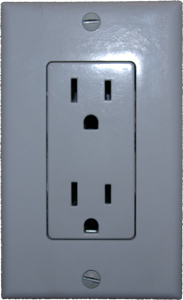
Let’s start at the wall. We see here a NEMA 5-15 Type B 3-Pin duplex socket. As you may notice, the left slot is slightly taller than the right one. This is the neutral. The live line is on the right, and the ground is on the bottom.
This socket is rated for 5 Amps at 125 Volts. The definition and calibration of the Amp and Volt and other key values in the Metric or SI system of measurement are standardized by the General Conference on Weights and Measures (CGPM).
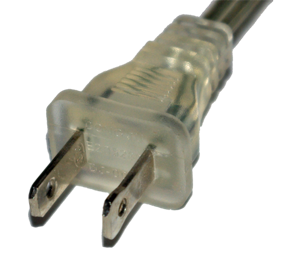
From the lamp we have the male end, an AC power plug. On my lamp the connector is a polarized, ungrounding NEMA 1-15P plug.
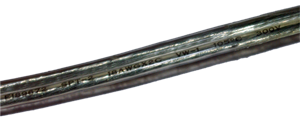
This is an electrical cord for the lamp. The codes indicate that this is a SPT-2 , #18 gauge flexible cord. SPT (Service Parallel Thermoplastic) is a standard defined by the American Society for Testing and Materials (ASTM) and approved by Underwriters Laboratories (UL). The gauge is measured in American Wire Gauge (AWG) units, also known as the Brown & Sharpe gauge, a standard dating back to 1855.
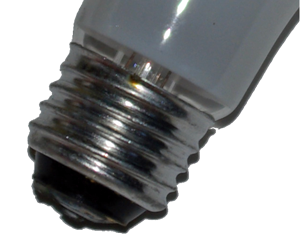
A critical interface is the one between the bulb and the lamp. The most-common connection in the United States is called the MES or Single Contact Medium Edison Screw (E26). This is an ANSI Standard, C78.20-2003.
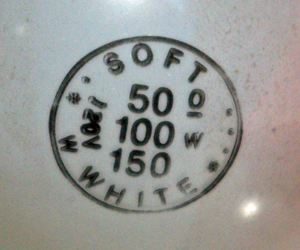
The bulb itself is an NEMA A21-style bulb, with an E26d style base. It will be 134.9 mm long, 28.2mm wide at the base. The height of the conductor screw will be 24.4mm. As indicated, this is a three-way bulb, rated at 50W, 100W and 150W.
As you can see, the inputs and outputs of the lamp are heavily-constrained by a number of standards. Is this a bad thing? Is the consumer deprived for not having to worry about different plug and outlet types, or what gauge cord to use for their lamp, or what thread connection to use? On the contrary, it is a blessing for the consumer that such pieces are interchangeable commodities.
If one bulb burns out, you can replace it with whatever brand is cheapest. Or you can get a lower wattage one to save electricity. Or even get a florescent one that fits in the same Medium Edison Screw socket. You can get clear glass, soft white, red glass or black light. You have these choices because bulb standards make bulbs interchangeable.
If the dog chews on the cord and you need to replace it, there is no need to return the lamp to the manufacturer at great expense. SPT-2 cords are standard and available at any hardware store. You can simply replace it yourself.
If you move to another house, will your lamp stop working and need to be thrown out? No, of course not. The NEMA 15-5 power outlets are in every home in North America. You can use your lamp wherever you go.
What if you want to buy a new lamp next year, will you need to change the wiring or the outlets in your house to work with it? Certainly not. The power outlets are a standard will work with any lamp, the ones you have today, the old ones you buy at an flea market, or the ones you buy 10 years from now. The standards ensure interoperability, interchangeability and substitutability.
In fact, far from constraining choice, standards enable greater choice. Because the basic plugs, receptors and connectors are governed by standards, these core components have become commodities and are produced off-shore at low cost to you, the consumer. This causes lighting designers and manufacturers to compete on the basis of style, elegance, utility and features. So standards result in lower cost, greater competition and greater choice for the consumer.
These are the choices enabled by standards, and the choices that consumers want:
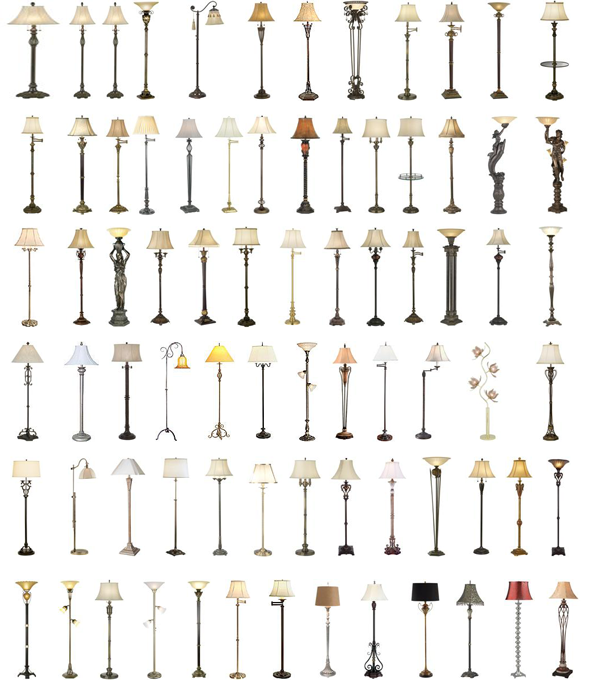
It is the same thing with document formats. Consumers don’t want to worry about document formats. They don’t want to even think about document formats. They just want them to work, invisibly, without problems. Of course consumers want choice, but it is the choice of applications, choice of features, choice of vendors, choice of support options, choice of open source versus proprietary source, choice of heavy weight versus web-based, a choice of buying a single application versus buying a suite, etc. A single universal file format is what makes these other choices possible, just like a choice of the Medium Edison Screw bulb leads to an affordable choice in lamp designs.
To perpetuate vendor-specific file formats is like having a lamp that requires a special plug and a special light bulb and even special electricity. It is to go through life with a bag full of adapters and transformers that you will need to apply whenever you, or someone else, needs to use your document in another application. The cost of multiple document standards is that the industry will invest in a wide variety of convertors between the formats, and this cost will be passed on to the consumer. These convertors will work sometimes, but will inevitably be slower, buggier, have less fidelity, and their availability will lag the office applications by months or years.
The choice is yours.
Updates:
2/14/2007: A discussion of one critic’s response to this essay can be read in this follow-up.